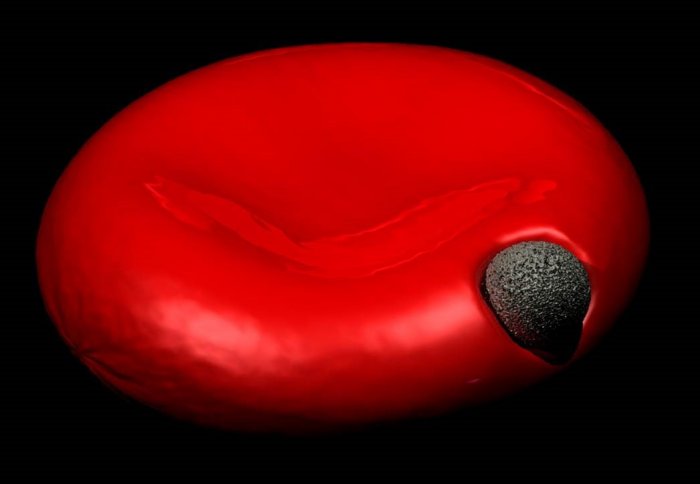Malaria parasites soften our cells' defences in order to invade

Malaria parasite entering a red blood cell
Malaria parasites cause red blood cells to become bendier, helping the parasites to enter and cause infection, says a new study.
Malaria is caused by a family of parasites that are carried by mosquitoes. Once parasites enter the body through a mosquito bite, they multiply in the liver before invading red blood cells where they cause the symptoms of malaria disease.
This could also mean that naturally more flexible cells would be easier for parasites to invade, which raises some interesting questions.
- Marion Koch
The parasites have molecular motors that allow them to push their way into cells, and this was thought to be all that was required for invasion. However, now researchers led by a team at Imperial College London have found that the parasites also change the properties of red cells in a way that helps them achieve cell entry. The results are published in Proceedings of the National Academy of Sciences.
On binding to the surface of the red cell, the parasites cause the red cell membrane to become more bendy or pliable, making it easier for the driving parasite to push inside.
Differences in red blood cell stiffness, due to age or increased cholesterol content, could influence the parasite’s ability to invade. This suggests that red blood cells with higher cholesterol levels could remarkably be more resistant to invasion and therefore infection.
Investigating the host
Lead author of the study Marion Koch, from the Department of Life Sciences at Imperial, said: “We have discovered that red cell entry is not just down to the ability of the parasite itself, but that parasite-initiated changes to the red blood cells appear to contribute to the process of invasion.
“This could also mean that naturally more flexible cells would be easier for parasites to invade, which raises some interesting questions. Are parasites choosy about which cells to invade, picking the most deformable? Is susceptibility to malaria modified by fat or cholesterol content, or the age of circulating red blood cells?”
Lead researcher Dr Jake Baum, also from the Department of Life Sciences at Imperial, added: “This suggests we should be investigating not just parasite biology, but also how the body’s own red blood cells respond.
“There are therapies developed for diseases like HIV that strengthen the body’s responses in addition to tackling the ‘invader’. It’s not impossible to imagine something similar for malaria, for example looking at a host-directed drug target and not just the parasite.”
Measuring deformability
In order to bind to red blood cells, the parasite carries molecules that interlock with receptors on the cells’ surface. These molecules are similar to those used by the body’s own immune system to alter the cells’ properties, so the team wondered if they did the same thing for the parasite.
To find out, the team exposed red blood cells to parasite molecules and measured how much cells deformed as a result.
In one method, in collaboration with the University of Dresden, they filmed 1000 cells per second passing through a narrow channel. Using this approach, they were able to determine cell deformability by measuring how elongated the cells became during transit through the channel.
Video caption: Red blood cells flowing through microfluidic real-time deformability cytometry chamber. Credit: Technische Universität Dresden
Next, the team collaborated with Dr Nicholas Brooks from the Department of Chemistry at Imperial to precisely measure where this deformation came from. They measured how much the cells deviate from their normally circular shape as their membranes naturally fluctuate or flicker.
Video caption: Red blood cell membrane fluctuations recorded at 150 frames per second. Credit: Imperial College London
The critical change appeared to be to the ‘bending modulus’ of the cells. The bending modulus is a measure of how much energy it takes to bend the cell membrane. The molecules tested reduced the bending modulus, meaning the parasite would require less energy to push its way in.
-
'Plasmodium falciparum erythrocyte binding antigen-175 triggers a biophysical change in the red blood cell that facilitates invasion' by Marion Koch et al, is published in PNAS.
Article text (excluding photos or graphics) © Imperial College London.
Photos and graphics subject to third party copyright used with permission or © Imperial College London.
Reporter
Hayley Dunning
Communications Division
